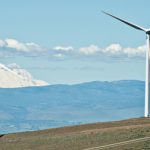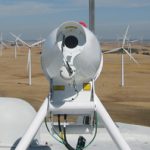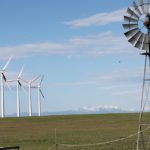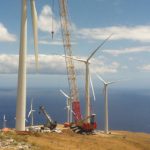When most people think of the Pacific Northwest they envision lush green forests and majestic mountain ranges. The region is “green” in more than one way. The forests and mountains of much of the Pacific Northwest are wonderfully green, but so is an increasing amount of the energy flowing from that region. Thousands of megawatts of green energy are being produced by wind farms in the Columbia Gorge Bi-state Regional Energy Zone (CG-BREZ); a six-county region straddling the Columbia River in both Oregon and Washington. The Oregon counties of Sherman, Gilliam, Wasco, and Hood River and two Washington counties—Klickitat and Skamania—make up this renewable energy zone. The Mid-Columbia Economic Development District (MCEDD) has responsibility for administration and direction of CG-BREZ activities.
A Collection of Counties
Wind farms include some of the largest developments in the U.S.: Shepherds Flat (General Electric Renewables and Caithness Energy); Biglow Canyon (Portland General Electric); Klondike I, II, and III (Iberdrola), and Cannon Energy’s Windy Point/Windy Flat, Big Horn, and Big Horn II are among projects ranging in size from 75MW to 600MW. CG-BREZ members represent the highest wind energy producers in both Oregon and Washington.
The counties comprising CG-BREZ are developing a world-class renewable energy region emphasizing research and development, innovation, education, workforce training, and business development. The Columbia River Gorge contains virtually everything that makes the Pacific Northwest desirable: unrivaled scenic beauty that includes mountains, rivers, and plains, coupled with abundant recreational opportunities. In the Columbia Gorge you can enjoy four-season outdoor recreation: fishing, hiking, camping, cycling, kayaking, year-round skiing and snowboarding, sailing, windsurfing, kite boarding, rock and mountain climbing, waterskiing and wakeboarding, biking—even spelunking. Long-established small communities offer great schools and quaint, small-town flavor.
A broad inventory of industrial property, multi-modal transportation, renewable energy technology training, a favorable business climate, and high-speed data services complement this high quality of life. The Columbia Gorge offers market access by interstate highway, river, rail, and air. Both states are considered business-friendly and are highly ranked for business recruitment. The area boasts a strong regional economy. Companies like Google, Insitu (a Boeing subsidiary), many green technology businesses, and clusters of small companies create a dynamic environment.
Harnessing the Wind
Windy it is, especially as the mile-wide Columbia River creates a nearly sea-level cut through the Cascades, drawing thermals between two distinct climates: the warm, arid east and the cool, damp west, creating ideal conditions for windsurfing and paragliding.
Sports enthusiasts aren’t the only ones excited about the reliable and consistently strong winds that blow through the Columbia Gorge. As a renewable resource, the winds have brought billions of dollars in private investment in wind energy projects. Winds have always blown in the Gorge, but now they are making a genuine contribution to the nation’s energy independence.
The region’s long-established hydroelectric dams and abundance of high-capacity electrical transmission lines produce and distribute energy to the surrounding western U.S. energy markets. Reliable winds, transmission capacity, and growing national demand for green energy to replace fossil fuels are key elements for a thriving wind industry. Figure 1
Bonneville Power Administration (BPA), a key facilitator of energy production for many decades, integrates wind in concert with hydropower. Additional transmission capacity is being pursued. Local public utilities also partner in wind energy projects.
Regional Resources
An essential element to the wind industry’s success is premier workforce training by Columbia Gorge Community College (CGCC) in The Dalles, Oregon. An initial assessment in 2006 indicated local wind projects would need 360 technicians by 2011. This has now jumped to 1,200 or more technicians, and training in other Oregon and Washington community colleges and universities also helps fulfill the growing demand.
The American Wind Energy Association recognized the pioneering Renewable Energy Technology Program at CGCC with one of its first three Seals of Approval in January 2011. The present program includes a nine-month certificate that qualifies a student as a wind turbine technician, emphasizing safety, electronics, mechanics, and hydraulics, with a foundation in math and real-world problem solving. A two-year associate degree of applied science (AAS) broadens career options with greater depth and expertise. CGCC credits are transferable, and students can pursue higher-level four-year university degrees. The industry-endorsed skills training is supported by industry partners, the State of Oregon, and a U.S. Department of Labor training grant, with additional funds directed by Congress through the U.S. Department of Energy.
The six counties of CG-BREZ are amazingly diverse in climate and terrain. The western counties receive nearly 50 inches of rain annually and have lush forests, tumbling rivers, abundant fishing and hunting. Eastern counties are largely classified as high desert prairie land. Rainfall is less than 10 inches in most areas and much of the farming is dry-land.
The region’s diversity is also reflected in its crops, ranging from cherries, apples, and pears to thousands of acres of wheat, along with cattle, horses, and sheep. The bi-state region boasts some of the best vineyards and wineries in the Northwest.
Economic Benefits
Before wind energy projects began to appear around the U.S., rural counties along the Columbia River in Oregon and Washington were for the most part sparsely populated, not particularly wealthy, and all were looking for ways to improve local economic conditions. The economic shocks suffered by one county were often felt by the others, due to proximity and a shared workforce.
One county that was looking for a way to overcome severe economic shocks was Klickitat County, Washington. Some 12 years ago, when the county was struggling to find ways to overcome two devastating economic setbacks to its local economy (closure of a large aluminum smelter and federal restrictions on timber harvest to protect the Spotted Owl), county leaders decided to aggressively encourage wind energy development. Local ranchers welcomed some of the earliest wind studies and proudly displayed turbines on their fields. Figure 2
Reductions in the timber industry were regional and all counties with timber resources immediately realized sharp losses in traditional revenues. Privately owned as well as government-owned forests became dormant, but the cost and work to maintain once-thriving timberlands continue to this day. This places a heavy economic burden on heavily forested Skamania County, Washington. Local economies were disrupted and have been very slow to recover from such a sudden and heavy loss of family-wage jobs. Chronic economic hardship became commonplace in most CG-BREZ member counties long before the renewable energy zone was organized.
Even before wind projects arrived, economically distressed Klickitat County invested $1,000,000 to develop a unique Energy Overlay Zone that addressed most permit requirements for wind projects in advance. This facilitated reliable and consistent permitting without lengthy bureaucratic delays. The effort succeeded: more than 1,000 megawatts of power are being generated at present and additional projects are planned. Farsighted leaders in a chronically poor rural county took those bold steps to improve the possibilities for attracting a new industry, and it worked very well.
New county tax revenues being generated by wind projects in these rural Oregon and Washington counties are having a positive impact on landowners and local schools, hospitals, libraries, and fire districts. Tax incentives that facilitated development of energy projects have local benefit. Families and communities that have struggled for generations to make a living on farms or ranches, often under harsh drought conditions, are now beginning to prosper from energy lease payments and energy generation royalties.
Heavy Hitters
The region is clearly united in its effort to grow wind projects, and all the major energy companies are working actively on projects large and small. Several projects are into their second and third build-out phase, collectively providing a “Who’s Who” list of companies including Iberdrola, Vestas, Siemens, enXco, General Electric, Cannon Energy, Repower, Puget Sound Energy, Suzlon, Portland General Electric, Horizon, and Mitsubishi, among others. Figure 3
Prospects are changing for counties in the Pacific Northwest, including members of the Columbia Gorge Bi-state Renewable Energy Zone. Efforts are being made as a region and by individual counties to attract wind energy related manufacturing. Residents of the CGBREZ counties are also beginning to realize wind energy is here to stay, and many elements of the energy industry have yet to arrive. The present turbines, blades, and towers will require routine repairs, maintenance, inspection, and certification services, and property security services, as well as equipment updating and replacement. Many of these services will be provided by homegrown service companies and regional service centers structured to respond to the industry’s needs.
Conclusion
The positive attitude and good-neighbor efforts exhibited by wind energy developers toward local communities and counties has built a partnership for further economic development. More and more wind jobs are being filled by locally trained wind technicians, and families that would have had to move away from their home communities are often finding there are great opportunities growing all around them in the wind farms.







































